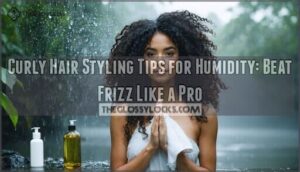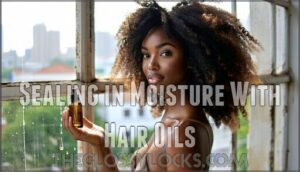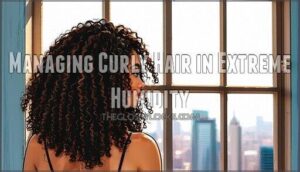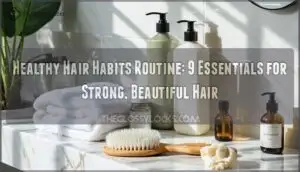This site is supported by our readers. We may earn a commission, at no cost to you, if you purchase through links.
 Humidity wreaks havoc on curly hair by causing the cuticles to lift and absorb moisture from the air, creating that dreaded frizz halo.
Humidity wreaks havoc on curly hair by causing the cuticles to lift and absorb moisture from the air, creating that dreaded frizz halo.
Your best defense is to start with curly hair styling tips for humidity that actually work.
Load up on leave-in conditioner while hair’s still damp, then seal with a lightweight oil to create a moisture barrier.
Apply gel or mousse using the "praying hands" method to encourage curl formation without disruption.
Skip the towel – scrunch with a microfiber cloth instead.
When humidity levels spike, protective styles like loose braids or silk scarves become your secret weapons for maintaining definition and preventing your curls from staging a rebellion.
Table Of Contents
- Key Takeaways
- Humidity Effects on Curly Hair
- Minimizing Frizz in Humid Weather
- Curly Hair Styling for Humidity
- Protective Styling for Humid Environments
- Managing Curly Hair in Extreme Humidity
- Frequently Asked Questions (FAQs)
- How do I stop humidity from ruining my curls?
- What is the best hair style for humid weather?
- How to get curly hair to hold moisture?
- What is the best product to hold curls in humidity?
- How to style curly hair in humid weather?
- How to protect curly hair against humidity?
- How to style hair on a humid day?
- How do I make my hair look good in humidity?
- How can I reduce frizz when wearing curly hair down?
- What humidity levels should I be concerned about for frizz?
- Conclusion
Key Takeaways
- Create a moisture barrier before styling – Apply leave-in conditioner to damp hair, then seal with lightweight oil to prevent humidity from penetrating your cuticles and causing frizz.
- Use the "praying hands" technique with gel – Apply strong-hold gel to damp hair using smooth, downward motions to encourage curl formation and create a protective cast against humidity.
- Ditch the towel for microfiber – Scrunch excess water with a microfiber cloth instead of a regular towel to prevent cuticle damage and maintain curl definition.
- Monitor dew point, not just humidity – Watch for dew points above 60°F when your hair becomes a moisture magnet, and adjust your product routine accordingly for better frizz control.
Humidity Effects on Curly Hair
When humidity hits your curls, it’s like opening the floodgates to frizz city.
Humidity turns your perfect curls into a frizzy tornado faster than you can say "bad hair day.
Your hair’s cuticles act like tiny moisture magnets, swelling up and creating that dreaded pouf that makes you want to hide under a hat all day.
How Humidity Causes Frizz
The science behind frizz formation starts when humidity levels spike above 60%.
Your hair shaft swells as it absorbs atmospheric moisture, disrupting hydrogen bonds in keratin proteins.
This hair swelling lifts cuticles, creating rough texture and that dreaded pouf.
High humidity basically hijacks your curl pattern, turning defined spirals into a fuzzy mess through cuticle damage and uncontrolled moisture absorption.
Understanding hair frizz causes is vital to developing effective strategies for managing curly hair in humid environments.
Impact of Dew Point on Curly Hair
Unlike regular humidity percentages that can mislead you, dew point reveals the true moisture story your curls face.
When dew point climbs above 60°F, your hair becomes a moisture magnet, absorbing atmospheric water and losing curl definition.
Below 35°F, your curls crave hydration as dry air steals moisture away.
Understanding dew point control empowers better frizz prevention and humidity management decisions.
To manage curly hair effectively, consider using dew point guides to make informed product choices.
Role of Hair Cuticles in Frizz
Your hair cuticle acts like your curl’s armor against humidity’s assault.
Your cuticles are your first line of defense against humidity’s frizz-inducing chaos.
When moisture penetrates damaged or porous cuticles, your hair swells and loses curl definition.
Healthy cuticles lie flat, creating a protective barrier that maintains moisture balance and prevents frizz.
Poor cuticle care leaves your curls vulnerable to humidity’s chaos, while proper cuticle structure keeps your curls defined and frizz-free.
Minimizing Frizz in Humid Weather
When humidity strikes, you need the right arsenal to keep your curls smooth and defined instead of turning into a frizzy mess.
The key is layering moisture-sealing products that work together to create a protective barrier against atmospheric moisture.
Using Anti-Frizz Styling Products
Something magical happens when you arm yourself with the right frizz control arsenal.
Start with hair serums containing silicones—they’re your first line of defense against humidity.
Layer styling creams over damp hair, then seal with anti frizz spray for maximum protection.
This product layering technique creates multiple barriers, maintaining moisture balance while blocking atmospheric moisture that causes frizz.
Effective hair care involves understanding anti frizz products, including those found through hair spray solutions.
Applying Leave-in Conditioner for Moisture Lock
Locking in moisture becomes your secret weapon against humidity’s frizz-inducing assault. Apply leave-in conditioner to damp hair, focusing on mid-lengths and ends where dryness strikes hardest.
This moisture lock creates a protective barrier, preventing atmospheric water from penetrating your cuticles. Choose lightweight formulas with humectants that’ll boost hair hydration without weighing down your curls—your frizz prevention strategy starts here.
Understanding the best leave in conditioners is essential for effective hair care in humid environments, and using them is a key part of your frizz prevention strategy.
Sealing in Moisture With Hair Oils
After locking in moisture with leave-in conditioner, hair oils act as your final defense against humidity’s moisture-stealing effects.
These oil benefits include creating a protective barrier that prevents external moisture from penetrating your hair cuticle.
Apply lightweight hair serum or oil blends like argan or jojoba to damp curls for ideal curl nourishment and hair sealing, boosting humidity resistance while maintaining natural curl definition.
Using the right hair oil serum products can substantially enhance the effectiveness of this method, providing curl nourishment and ensuring a natural curl definition.
Curly Hair Styling for Humidity
When humidity strikes, your curls need strategic styling to stay defined and frizz-free.
The right combination of products and techniques creates a protective barrier that locks in moisture while keeping unwanted humidity out.
Using Gel for Definition and Hold
When battling humidity’s relentless grip on your curls, hair gel becomes your secret weapon for curl definition and frizz control.
Strong-hold gel products create a protective cast that locks in moisture while blocking environmental humidity from disrupting your curl pattern.
- Apply gel to damp hair using the praying hands technique for even distribution
- Choose anti-humidity formulas with polymers like VP/VA copolymer for maximum hold
- Scrunch out the gel cast after drying for soft, touchable curls with lasting definition
Applying Mousse for Extra Definition
Mousse benefits your curls by providing lightweight hold without weighing them down.
Apply to damp hair using scrunching motions to enhance curl definition and texture. This product layering technique creates volume while maintaining natural bounce.
Choose alcohol-free formulas that won’t dry out your hair moisture, giving you better humidity control and stronger frizz fighting power.
Sandwich Styling for Maximum Hold
Sandwich styling layers multiple products for maximum frizz prevention and curl definition.
Start with leave-in conditioner, add gel for hold enhancement, then seal with lightweight oil. This layering technique creates a protective barrier against humidity while maintaining bounce.
The method combines styling products strategically, giving you bulletproof curls that laugh at Mother Nature’s mood swings.
Understanding curly hair basics is essential for effective styling and maintaining healthy curls that showcase your natural beauty with maximum definition.
Protective Styling for Humid Environments
When humid weather threatens to turn your curls into a frizzy mess, protective styling becomes your best defense strategy.
These time-tested techniques keep your curls contained and shielded from moisture-laden air that wants to wreak havoc on your hair.
Ponytails and Buns for Minimal Frizz
High ponytails and sleek buns are your secret weapons against humidity’s frizz attack.
These updo techniques lift curly hair away from your neck and shoulders, reducing contact with humid air.
Position your ponytail high on your crown using gentle hair ties to prevent breakage.
For buns, loosely twist sections before securing—this creates volume while maintaining frizz control through strategic hair tucking methods.
By incorporating techniques that promote hair growth patterns, you can better protect your hair from damage and breakage, using complete concepts and strategic hair tucking methods to achieve frizz control and support hair growth.
Braids and Twists for Frizz Control
Braids and twists become your secret weapons against humidity’s frizz attacks.
These protective styles shield your curls by reducing surface area exposed to moisture-laden air.
Try French braids or twist-outs using humidity-resistant products before styling.
The key lies in proper braid techniques and twist styles that maintain curl preservation while providing superior frizz control through strategic hair tucking methods.
Scarf Styling for Added Protection
Wrapping your curls in a silk scarf creates an invisible shield against humidity’s sneaky attacks.
This hair protection technique works by creating a barrier that prevents moisture from penetrating your curl pattern.
Silk scarves and satin bonnets offer superior frizz control compared to cotton alternatives, which can absorb your hair’s natural oils.
These protective styles maintain curl preservation while you’re outdoors, making them essential humidity resistance strategies for particularly challenging weather days.
Managing Curly Hair in Extreme Humidity
When humidity levels soar beyond your usual frizz-fighting arsenal, you’ll need to bring out the heavy artillery.
These extreme conditions call for strategic product layering and potentially seeking professional guidance to keep your curls defined and manageable.
Using Heavy-Duty Frizz Control Products
When protective styles aren’t enough, it’s time to bring out the heavy artillery.
Heavy-duty frizz control products contain powerful humidity-resistant ingredients that create an invisible shield around each strand.
- Silicone-based serums like dimethicone form protective barriers against moisture
- Film-forming sprays with polyquaternium-59 lock down cuticles for hours
- Anti-humidity creams with water-resistant polymers repel atmospheric moisture
- Heat-activated treatments intensify when blow-dried for maximum protection
These frizz fighters work best when applied to damp hair before other styling products.
Using the right frizz control serum can make a significant difference in managing curly hair.
Applying Additional Styling Products
When regular frizz-fighting products aren’t enough, product layering becomes your secret weapon.
Start with leave-in conditioner, then apply styling creams for moisture retention. Follow with hair serums containing humidity-resistant ingredients, and finish with frizz sprays or curl enhancers.
This multi-step approach creates powerful barriers against moisture invasion, giving you maximum control over stubborn curls.
Understanding curly hair hydration methods is essential for managing curly hair in extreme humidity, and using the right techniques is key to achieving maximum control.
Seeking Professional Hair Advice
Sometimes the best curly hair styling tips come from professional hair consultations.
Stylists specializing in curly textures offer personalized advice customized to your specific curl pattern and porosity.
Expert guidance helps identify humidity-resistant products and antihumectants that work for your hair type.
Salon services like keratin treatments provide long-lasting frizz prevention techniques, while stylist recommendations guarantee you’re using the right hair humidity management strategies.
Frequently Asked Questions (FAQs)
How do I stop humidity from ruining my curls?
Use anti-frizz products with silicones or emollients to seal your hair cuticle.
Apply gel to damp curls, then diffuse or air-dry completely.
Sleep on silk pillowcases and avoid touching styled hair.
What is the best hair style for humid weather?
Braids, twists, and protective updos work best in humid weather.
They shield your curls from moisture while maintaining definition.
Try a high bun or pineapple style to keep hair off your neck and minimize frizz-inducing contact with humid air.
How to get curly hair to hold moisture?
Deep conditioning treatments with humectants like glycerin draw moisture into your hair shaft.
Follow with emollients like shea butter to seal it in.
You’ll lock in hydration and prevent dryness that leads to breakage.
What is the best product to hold curls in humidity?
Strong-hold gels with anti-humectant ingredients like polyquaternium-11 work best for locking in curl definition.
Apply gel to damp hair, then diffuse or air-dry completely to create a protective barrier against moisture.
How to style curly hair in humid weather?
Think of humidity as a moisture magnet pulling water into your curls like a sponge.
Apply anti-frizz cream to damp hair, use the "praying hands" technique, then diffuse on low heat.
Finish with lightweight oil to seal the cuticle and lock out excess moisture.
How to protect curly hair against humidity?
Use anti-humectant products containing silicones or oils to create a protective barrier.
Apply leave-in conditioners and gels on damp hair, then diffuse dry.
Sleep on silk pillowcases to maintain curl definition overnight.
How to style hair on a humid day?
Apply gel to damp hair, use the praying hands technique for even distribution, then diffuse with low heat.
Avoid touching curls while drying, and consider protective styles like braids or high buns to shield hair from humidity.
How do I make my hair look good in humidity?
Humidity’s your hair’s worst enemy, but victory’s within reach. Choose anti-frizz products with emollients like argan oil, apply gel to damp hair, diffuse gently, and protect overnight with silk pillowcases.
How can I reduce frizz when wearing curly hair down?
Your curls crave balance—apply lightweight anti-frizz serum to damp hair, then gently scrunch with a microfiber towel.
Avoid touching curls while they dry, and seal with a drop of argan oil for lasting smoothness.
What humidity levels should I be concerned about for frizz?
When Mother Nature cranks up her moisture dial, dew points above 60°F spell trouble for your curls.
You’ll notice increased frizz as humidity climbs past 70%, with peak challenges hitting around 80-90% levels.
Conclusion
Picture your curls as a fortress under siege from humidity’s relentless assault.
Armed with these curly hair styling tips for humidity, you’re now equipped to defend your definition against even the most aggressive weather conditions.
Remember that consistency beats perfection—your hair routine doesn’t need to be complicated, just strategic.
Start with moisture-locking products, seal with lightweight oils, and embrace protective styles when nature gets temperamental.
With practice, you’ll master these techniques and transform humidity from your hair’s worst enemy into a manageable challenge.











